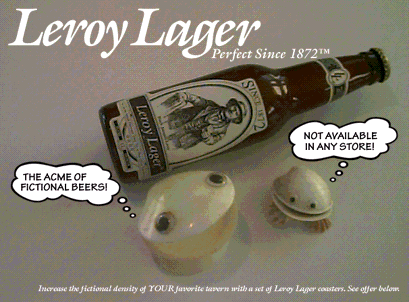
 rom
time to time, my parents would take me to stay for a weekend with my father's
large and sturdy parents, whom I called Big Grandfather and Big Grandmother,
or simply Grandfather and Grandmother. . . . rom
time to time, my parents would take me to stay for a weekend with my father's
large and sturdy parents, whom I called Big Grandfather and Big Grandmother,
or simply Grandfather and Grandmother. . . .
 Each
of these visits began with a climb up the stairs to the rooms where Great-grandmother
Leroy lived, at the very top of the house. . . . Each
of these visits began with a climb up the stairs to the rooms where Great-grandmother
Leroy lived, at the very top of the house. . . .
 The door at the top of the stairs was fitted with glass panes from top
to bottom, and Great-grandmother had hung a gauzy curtain over it. Through
the curtain I could see Great-grandmother sitting in a chair by the front
windows, where she was always sitting when I came to visit, carving a coconut
with a kitchen knife. . . .
The door at the top of the stairs was fitted with glass panes from top
to bottom, and Great-grandmother had hung a gauzy curtain over it. Through
the curtain I could see Great-grandmother sitting in a chair by the front
windows, where she was always sitting when I came to visit, carving a coconut
with a kitchen knife. . . .
 She had many little friends around the neighborhood, children I didn't
know, since at that time I lived all the way across town, away from the
water, and so didn't see any of these children at school. I visited only
occasionally and didn't have much time away from the adults when I was
visiting. Festoons of paper chains hung over every door and window, and
her shelves and tables were crammed with tissue paper carnations in juice
glasses and jelly jars, paper baskets, necklaces of painted macaroni, and
rows of knickknacks made from clamshells. But pride of place went to the
coconuts carved to represent Leroys. . . .
She had many little friends around the neighborhood, children I didn't
know, since at that time I lived all the way across town, away from the
water, and so didn't see any of these children at school. I visited only
occasionally and didn't have much time away from the adults when I was
visiting. Festoons of paper chains hung over every door and window, and
her shelves and tables were crammed with tissue paper carnations in juice
glasses and jelly jars, paper baskets, necklaces of painted macaroni, and
rows of knickknacks made from clamshells. But pride of place went to the
coconuts carved to represent Leroys. . . .
 The carving of these coconuts was a project that she had begun before I
could remember, but it was unlikely that it would ever be completed, since
she not only kept extending its scope to include more and more distant
relatives but regularly revised the carvings she had already done, working
to bring the features closer to what she remembered -- or supposed -- them
to be. She had completed heads of all the major Leroys that she had any
memory of, and was now filling out the ranks of minor cousins and people
related only by marriage; she had not yet carved a head of herself. Whenever
I visited, she would quiz me about the exploits of these Leroys, and I
had gotten them all down pretty well, but there were gaps in my understanding
of what I repeated for her, enough gaps so that the Leroy history as Great-grandmother
presented it seemed to me a perilously leaky affair that was likely to
sink if the weather got at all rough. Often, when I was reciting for her,
I employed a narrative analogue to a widely used technique for keeping
afloat a clamboat with a soft bottom, a boat that leaks more or less all
the time. One takes the boat out to the clam flats and there crawls under
the hull and pokes sawdust into any visible gaps and, for good measure,
gives the whole bottom a good coating. Then one drinks a few beers or digs
a few clams while the sawdust floats into the cracks and swells with water,
stopping, or at least slowing, the leaks. This is not a permanent solution,
of course, merely a stop-gap measure, but some boats have been kept afloat
this way for years. The hull provides the form, the sawdust the substance,
and the result is an artful deception: the illusion of a solid hull, an
illusion so substantial that the boat floats. Sometimes, when I was reciting
for Great-grandmother, I threw quite a lot of sawdust into the gaps, but
she rarely seemed to notice, or if she did, she didn't seem to mind. .
. .
The carving of these coconuts was a project that she had begun before I
could remember, but it was unlikely that it would ever be completed, since
she not only kept extending its scope to include more and more distant
relatives but regularly revised the carvings she had already done, working
to bring the features closer to what she remembered -- or supposed -- them
to be. She had completed heads of all the major Leroys that she had any
memory of, and was now filling out the ranks of minor cousins and people
related only by marriage; she had not yet carved a head of herself. Whenever
I visited, she would quiz me about the exploits of these Leroys, and I
had gotten them all down pretty well, but there were gaps in my understanding
of what I repeated for her, enough gaps so that the Leroy history as Great-grandmother
presented it seemed to me a perilously leaky affair that was likely to
sink if the weather got at all rough. Often, when I was reciting for her,
I employed a narrative analogue to a widely used technique for keeping
afloat a clamboat with a soft bottom, a boat that leaks more or less all
the time. One takes the boat out to the clam flats and there crawls under
the hull and pokes sawdust into any visible gaps and, for good measure,
gives the whole bottom a good coating. Then one drinks a few beers or digs
a few clams while the sawdust floats into the cracks and swells with water,
stopping, or at least slowing, the leaks. This is not a permanent solution,
of course, merely a stop-gap measure, but some boats have been kept afloat
this way for years. The hull provides the form, the sawdust the substance,
and the result is an artful deception: the illusion of a solid hull, an
illusion so substantial that the boat floats. Sometimes, when I was reciting
for Great-grandmother, I threw quite a lot of sawdust into the gaps, but
she rarely seemed to notice, or if she did, she didn't seem to mind. .
. .
 "Do you know which one of these heads is your father?" she asked.
"Do you know which one of these heads is your father?" she asked.
 "Yes. It's that one." I pointed to the one that she had identified as my
father. All the heads looked more or less alike to me; I distinguished
them primarily by location, although I could tell the women from the men
because the women wore hats, dusty hats with broken feathers or stained
bands of silk.
"Yes. It's that one." I pointed to the one that she had identified as my
father. All the heads looked more or less alike to me; I distinguished
them primarily by location, although I could tell the women from the men
because the women wore hats, dusty hats with broken feathers or stained
bands of silk.
 "Very good. Now which one is Black Jacques?"
"Very good. Now which one is Black Jacques?"
 "The one in the middle of that shelf."
"The one in the middle of that shelf."
 "You're a good boy, Peter. What was Black Jacques famous for?"
"You're a good boy, Peter. What was Black Jacques famous for?"
 "He invented beer." This was an old routine for us. Some time, much earlier,
I had made this mistake, and it had made her laugh, so I had perpetuated
it as part of the ritual of naming the ancestors.
"He invented beer." This was an old routine for us. Some time, much earlier,
I had made this mistake, and it had made her laugh, so I had perpetuated
it as part of the ritual of naming the ancestors.
 "No, no," she laughed. "Not all beer, just the best beer."
"No, no," she laughed. "Not all beer, just the best beer."
 "Leroy Lager," I said. "It was a sturdy and honest beer, a drink for sturdy
and honest folks, not like the insipid pisswater they try to pass off on
people nowadays."
"Leroy Lager," I said. "It was a sturdy and honest beer, a drink for sturdy
and honest folks, not like the insipid pisswater they try to pass off on
people nowadays."
 "Right!"
"Right!"
 "And on the back of each bottle was a poem, a poem that Black Jacques had
commissioned especially for the entertainment, enlightenment, or puzzlement
of Leroy Lager drinkers. He paid handsomely for those poems, and they raised
the tone of taverns across the land. The period when Black Jacques produced
that amber nectar has come to be known as the Golden Age of Brewing."
"And on the back of each bottle was a poem, a poem that Black Jacques had
commissioned especially for the entertainment, enlightenment, or puzzlement
of Leroy Lager drinkers. He paid handsomely for those poems, and they raised
the tone of taverns across the land. The period when Black Jacques produced
that amber nectar has come to be known as the Golden Age of Brewing."
 "And how well did Leroy Lager do in the days of Black Jacques?"
"And how well did Leroy Lager do in the days of Black Jacques?"
 "It depends on how you look at it. It was a great beer, and it had the
finest label in the history of beer-bottle-label publishing, but sales
were disappointing. Rotten, in fact. You can't sell pearls to swine." I
knew that wasn't quite right, but it was close.
"It depends on how you look at it. It was a great beer, and it had the
finest label in the history of beer-bottle-label publishing, but sales
were disappointing. Rotten, in fact. You can't sell pearls to swine." I
knew that wasn't quite right, but it was close.
 "Oh, that's wonderful," she said. "Black Jacques would have liked that.
So, who was his son?"
"Oh, that's wonderful," she said. "Black Jacques would have liked that.
So, who was his son?"
 "Great-grandfather. Fat Hank."
"Great-grandfather. Fat Hank."
 "Tell me about him."
"Tell me about him."
 "He wasn't always fat. When you first met him, he was quite the fellow.
Everybody's friend. You were just a slip of a girl, and he set your heart
aflutter when he tipped his hat to you."
"He wasn't always fat. When you first met him, he was quite the fellow.
Everybody's friend. You were just a slip of a girl, and he set your heart
aflutter when he tipped his hat to you."
 "I was young and foolish."
"I was young and foolish."
 "Yes. And by the time you saw him for what he really was, it was too late.
That's the tragedy of your life. If only you'd been born earlier, you might
have had the father, Black Jacques himself. Now that was a man! Fat Hank
wasn't half the man his father was, and he ruined the business as soon
as it came into his hands."
"Yes. And by the time you saw him for what he really was, it was too late.
That's the tragedy of your life. If only you'd been born earlier, you might
have had the father, Black Jacques himself. Now that was a man! Fat Hank
wasn't half the man his father was, and he ruined the business as soon
as it came into his hands."
 "How?"
"How?"
 "He turned Black Jacques's hearty brew into something so wishy-washy that
you couldn't tell it from water, except that you could get drunk on it,
and he began accepting flaccid and self-indulgent poems for the labels.
In place of a few trenchant and pithy lines on one of the Great Themes,
the Leroy label now offered the anguished sniveling of shiftless egoists
whose works were so rambling that some of their poems had to be continued
onto several labels, leading to the introduction of packages of six bottles
and, ultimately, cases of twenty-four. Well, the result of all this was
that after a few bottles anybody with a regret, a pang, a fear -- any weepy
drunk -- could write a poem suitable for the once-proud Leroy Lager label.
Many more poems were accepted, and the rate of pay for these dropped as
the number of poets increased. Sales of Leroy Lager boomed, since poets
drink a lot, and every drinker began to consider himself a poet. So, you
see, things tend to get worse as time goes by."
"He turned Black Jacques's hearty brew into something so wishy-washy that
you couldn't tell it from water, except that you could get drunk on it,
and he began accepting flaccid and self-indulgent poems for the labels.
In place of a few trenchant and pithy lines on one of the Great Themes,
the Leroy label now offered the anguished sniveling of shiftless egoists
whose works were so rambling that some of their poems had to be continued
onto several labels, leading to the introduction of packages of six bottles
and, ultimately, cases of twenty-four. Well, the result of all this was
that after a few bottles anybody with a regret, a pang, a fear -- any weepy
drunk -- could write a poem suitable for the once-proud Leroy Lager label.
Many more poems were accepted, and the rate of pay for these dropped as
the number of poets increased. Sales of Leroy Lager boomed, since poets
drink a lot, and every drinker began to consider himself a poet. So, you
see, things tend to get worse as time goes by."
 She sighed and smiled at me with a mixture of sorrow (because what I'd
said was so true) and pleasure (because I'd remembered it so well). . .
.
She sighed and smiled at me with a mixture of sorrow (because what I'd
said was so true) and pleasure (because I'd remembered it so well). . .
.
 ater,
as a young man, I went to work as an editor on the staff of The Young
People's Cyclopedia. This compendium of useful facts, historical anecdotes,
brief lives, practical instruction, oversimplifications, and misinformation
was compiled first in a small office above Jack's Twenty-Four Hour Jokes,
on the corner of Bolotomy and Main, in the heart of Babbington, and later,
when it had become an institution, in a concrete castle, one of those structures
that businesses build to show their nostalgia for feudalism, outside town
in a spot that had once been a potato farm and now held many industrial
and office buildings and was called, preposterously, a park. The entries
were written by a network of experts, amateurs, teachers, and housewives
who were assigned topics to develop within strict limits of space. To add
a little to the salary I received there, I wrote some entries myself, borrowing
as a pseudonym the name of a good friend, Eliza
Foote. As Eliza Foote, I wrote many entries in The Young People's
Cyclopedia, including entries for most of the Leroys, points of interest
in and around Babbington, bivalves, and friends and acquaintances who deserved,
it seemed to me, a little space on a library shelf. For the entry on Black
Jacques, I used some of what Great-grandmother had told me, and lots of
sawdust. ater,
as a young man, I went to work as an editor on the staff of The Young
People's Cyclopedia. This compendium of useful facts, historical anecdotes,
brief lives, practical instruction, oversimplifications, and misinformation
was compiled first in a small office above Jack's Twenty-Four Hour Jokes,
on the corner of Bolotomy and Main, in the heart of Babbington, and later,
when it had become an institution, in a concrete castle, one of those structures
that businesses build to show their nostalgia for feudalism, outside town
in a spot that had once been a potato farm and now held many industrial
and office buildings and was called, preposterously, a park. The entries
were written by a network of experts, amateurs, teachers, and housewives
who were assigned topics to develop within strict limits of space. To add
a little to the salary I received there, I wrote some entries myself, borrowing
as a pseudonym the name of a good friend, Eliza
Foote. As Eliza Foote, I wrote many entries in The Young People's
Cyclopedia, including entries for most of the Leroys, points of interest
in and around Babbington, bivalves, and friends and acquaintances who deserved,
it seemed to me, a little space on a library shelf. For the entry on Black
Jacques, I used some of what Great-grandmother had told me, and lots of
sawdust.
| LEROY, JOHN PETER "Black Jacques," 1836[?]-1906, American brewer, born
Algiers. Among beer drinkers, it is sometimes said of Black Jacques that
"He invented beer." Although this is not correct, it is arguably true that
he developed the best of beers; this was the legendary Leroy Lager, a sturdy
and honest drink, relative only by name to the insipid brew later marketed
by his son, John Henry ("Fat Hank"). Often credited (erroneously) with
having first marketed beer in pint bottles, Black Jacques did introduce
the now widespread practice of printing a poem on a label on the back of
each bottle, thus raising the tone of taverns across the land. The period
when Black Jacques himself ran the Leroy brewery has come to be known as
the Golden Age of Brewing. Sales of the original Leroy Lager were never
large, and Black Jacques grew increasingly bitter about its lack of success.
Like many another original, he labored under the delusion that something
of essentially limited appeal could, as the result of a mutation of public
taste, acquire a large and devoted following. In 1894, broken in spirit,
he gave the Leroy brewery to his son as a wedding present. Fat Hank, more
in tune with popular taste than his father, began brewing a beer that went
down more easily than the original, and he launched a promotional campaign
that set an industry standard. He continued to publish poems on the Leroy
labels, but required that each poem submitted be accompanied by six caps
from Leroy bottles, the only requirement for acceptance. At least partly
as a result of this practice, the number of poets began a steady increase
that has not yet peaked. Another more or less direct consequence was the
introduction of the six-pack (q.v.), which put six caps into the hands
of the bibulous scribbler at once, in an easy-to-handle package. Fat Hank
grew increasingly concerned that his success could not last. He calculated
that if sales continued to grow at their then-current rate, by the end
of the twentieth century every person in the world capable of holding a
pen in one hand and a beer bottle in the other would be spending every
evening drinking Leroy Lager and writing poems; foolishly, Fat Hank assumed
that this was an impossibility. He sold the brewery, in a move that seemed
like mad impetuosity from the outside but that Fat Hank, in his autobiography
Nobody's
Fool, described as the shrewdest decision he had ever made, admitting,
however, that his next move fell considerably short of it on the shrewdness
scale. He put all the proceeds into a series of service-stations-cum-clam-bars.
He claimed to have had a vision one restless night of an endless line of
motorcars inching along a paved road, each car filled with a happy family,
eating clams on the half shell. "Only a fool," he is said to have said,
"could fail to see that cars and clams are the coming things." The story
of the failure of this venture is a familiar one. Millions are acquainted
with the romanticized version that is the basis of the musical film The
Flop, and every business school student knows it like the back of his
hand, thanks to the lengthy chapter devoted to it in Cartel's basic text,
The
Big Book of Business Blunders. Essentially, blame can be ascribed to
three causes: (1) the difficulty of assembling a staff adept at both automobile
mechanics and cooking, (2) the incompatible odors produced by automobile
maintenance and clam cookery, and (3) Fat Hank himself, who, those in the
know aver, began to lose faith in his vision as soon as he had embraced
it. -- EF |
[excerpted from "Do Clams Bite?" in Little
Follies. Copyright © 1982 by Eric Kraft. All rights reserved.]
LEROY LAGER coasters. You can't buy
"The Acme of Fictional Beers" anywhere in the real world (yet), but you
can use these coasters under real beers until the fictional thing comes
along. They're the pulpy-paper style that you'll find in real bars.
Imprinted with the Leroy Lager logo and a picture of the Founder, Black
Jacques Leroy. There is, of course, a poem on the back of each coaster.
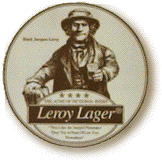 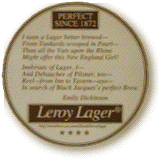
|












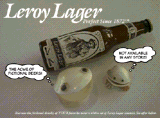
|

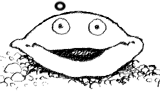 Happy Asa Clam
Happy Asa Clam
Spokesmollusk for Babbington
"Clam Capital of the World" |






